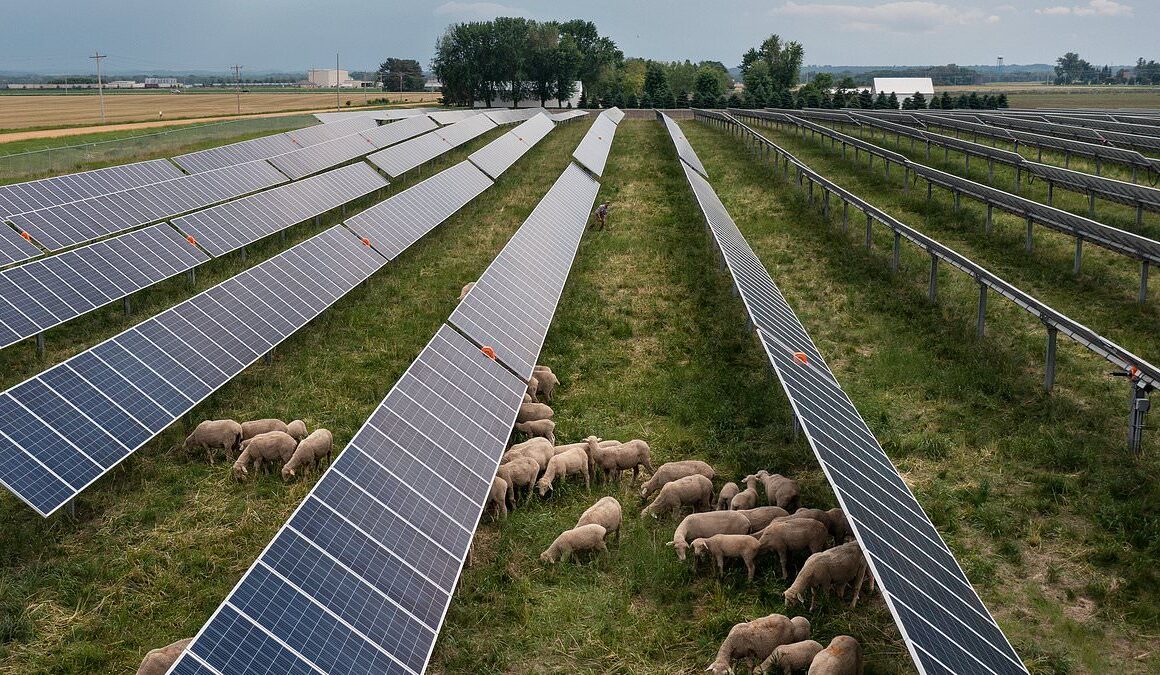Trouble is brewing across the Midwest.
Fuelled by President Joe Biden‘s climate incentives, renewable energy projects have flooded its sunny and windy sweeps of farmland.
As well as providing megawatts of clean energy, a $130 renewables industry is also dividing tight-knit rural communities.
Michigan farmer Clara Ostrander knows how clean energy can create a filthy atmosphere.
When she heard about the benefits of hosting a solar energy project, she remembered something her dad said four days before he died.

Michigan farmer Clara Ostrander, 57, understands that clean energy can create a dirty atmosphere.

Cows graze on a pasture surrounded by solar panels on a farm in Bruneau, Idaho
‘Don’t sell the farm. Keep it in the family,’ he said.
Skeptical at first, Ostrander ultimately decided to harvest the sun on most of her 120-acre corn-and-soybeans farm south of Detroit.
The 57-year-old believed it would enable her to someday pass the land to her son.
But the project proposed by Virginia-based Apex Clean Energy faced stiff opposition from neighbors who feared lower property values, the spoiling of farmland, and the end of the area’s pretty views.
They lobbied township officials for zoning rules to block it.
Ostrander and other neighbors fought back, convincing Michigan lawmakers last year to enact a statewide permitting law that stops local authorities from nixing big projects.
‘We’re trying to do exactly what our forefathers did, and keep our property they worked so hard for,’ Ostrander said.
The problem stretches far beyond Michigan.
Nationwide, opponents had used 395 local ordinances like the one in Ostrander’s township to halt green energy projects in 41 states by May 2023, says Columbia Law School’s Sabin Center for Climate Change Law.
Even Michigan’s new state law, which takes effect this fall, is not sure to last.
Opponents say the legislation is an affront to the democratic process and seek a referendum to return those decisions to the local level.
‘We have deliberately kept the value of farm ground low,’ said Kevon Martis, who leads the ballot initiative group, called Citizens for Local Choice.
‘It’s laying there cheap, and it’s a perfect target for high land-use-intensity developments like wind and solar. I just think that’s fundamentally wrong.’
Martis, a county commissioner, has railed against wind and solar projects in Michigan and elsewhere for more than a decade.
Only in recent years have longtime family farmers like Ostrander emerged as unexpected Yes-in-My-Backyard supporters on the other side
That lends developers political capital to get proposals over the finish line.
When township meetings draw a crowd, it’s traditionally been the ‘people who want to stop something,’ said Matthew Eisenson, a senior fellow at the Sabin Center, which assists pro-energy farmers.
If the supportive landowners don’t chime in, he said, ‘the impression on the siting board might be that it’s the developer versus the community — when in fact that’s not what’s going on.’

Critics blame President Joe Biden’s climate tax breaks and incentives in the Inflation Reduction Act

Sheep graze underneath solar panels at a farm in Hammond, Minnesota: an increasingly common sight across the Midwest

Michigan State Representative Pauline Wendzel, says rural residents are angry about the clean energy projects
The Biden administration’s goal of net-zero emissions from the power sector by 2035, as well as state requirements on clean energy standards, have accelerated the scramble to find sites for solar arrays and wind turbines.
Local zoning restrictions have increasingly been a thorn in its side.
That’s prompted some states to act, particularly those where Democrats control both the governor’s mansion and the state legislature.
In one such state, Illinois, Gov. JB Pritzker signed a law in 2023 barring local governments from vetoing renewable energy projects, so long as those projects met state standards.
Wisconsin and Minnesota have had state siting authority for a decade, but Minnesota, where
Democrats also hold the state government trifecta, further cut regulatory requirements for renewable energy projects over the past two years.
The renewable projects are ‘important at a statewide level, not just at a local level,’ said Dan Scripps, chair of the Michigan Public Service Commission.
‘And that is reflected in terms of having the state have a role in the process, if ultimately it gets bogged down at the local level.’
Developers typically need five to 10 acres for every megawatt of solar capacity, according to the Solar Energy Industries Association.
In Michigan, the average project is estimated to generate 158 megawatts, which means it could require at least 790 acres.
So while a 10-acre solar farm might not have a huge impact on views or taxes, one that spans 600 football fields is large enough to generate significant positive and negative reaction — such as more tax revenue but also more sound pollution — within communities, said Sarah Mills, from the University of Michigan.
Consider White River Township. With its rolling hills and waterfront vistas of Lake Michigan, the town 50 miles northwest of Grand Rapids draws people specifically looking to commune with nature.
Now residents, including many who lean Democratic and support renewable energy, are trying to accept that their views will soon include 1,700 acres of dark blue solar panels.
Sacrificing nearly one-fifth of the township’s total area is ‘heartbreaking,’ said Mary Jo Ernst, a caretaker and artist whose family has lived in the area for 85 years.
Her neighbor, Shirley Grattifori, said she and her husband put about $300,000 into renovating what they thought would be their ‘forever home’ in White River.
Instead, they’re considering selling before the solar farm takes root.
But with the state in charge of approving projects, moving anywhere in
Michigan is a gamble, the women agreed.
‘With this new law, where do you go?’ Ernst said.
The Michigan Farm Bureau, as well as statewide associations representing counties and bureaus, slammed the law as an overreach, even undemocratic.
‘In my district, the people of Decatur spoke loudly and clearly when they shot down a solar ordinance’ with 80 percent voting against it, said Republican state representative Pauline Wendzel.
‘Now with this legislation, Democrats are telling Michigan residents that elections don’t matter, and their voices don’t count.’
Apex Clean Energy arrived in 2020 in Ostrander’s community of Milan Township, about 40 miles from Detroit, during a growth spurt for the company.
Today, Apex operates 30 clean energy sites generating eight gigawatts, enough capacity to power more than 3 million average American homes.
Projects under development in Michigan range from a 50-megawatt solar farm in the southwest to a 375-megawatt wind farm farther north.

Mary Jo Ernst, a caretaker and artist, said it was ‘heartbreaking’ to see green spaces turned into energy projects

Ostrander and her husband, Leonard, both have costly medical issues.
Ostrander, a lifelong resident of Milan Township and a past winner of Homemaker of the Year at the Monroe County Fair.
After inheriting her family’s farm, Ostrander leased most of it to a local corn and bean farmer.
But she also tends 35 goats and two horses and harvests 15 acres with her husband and a small crew.
These days agricultural or commodity farming alone often can’t pay the bills — for the farmers or their communities, which need the tax revenue to cover basic services, she said.
Ostrander and her husband, Leonard, both have costly medical issues.
Renting her land just for corn and soybeans wasn’t going to cover her rising tax payments, let alone the work needed on two century-old homes she inherited, she said.
In 2022, she leased 100 acres to Apex to help build out Azalia Solar, which would generate enough electricity to power 26,000 homes, according to the developer’s website.
Ostrander declined to discuss details of the arrangement.
More than half of large farmers nationally say they have been offered $1,000 per acre each year for solar leases, up from the roughly $750 per acre reported in 2021, according to a Purdue University study.
Kevin Heath, Ostrander’s longtime neighbor and friend whose family owns swaths of land in the township, agreed to lease all 500 of his acres to Apex the same year.
Heath figured that, compared to a residential housing project, solar is a lower-impact development that actually protects farmland.
If he were motivated only by money, he said, he could sell to an out-of-state agriculture investment company for up to $7,000 an acre.
‘If we wanted to be greedy, we could all sit right now in a pile of money,’ Heath said.
The pushback from opponents in the 3,534-person township was intense.
Heath said he could feel the contempt from people he had built decks for, gone to church with and known since kindergarten.
‘Normally I would swing by and say ‘Hi’ if I’m going around the block,’ Heath said.
‘Not anymore.’
Heath, Ostrander and their allies soon confronted a reality: They were relatively large landowners, but outnumbered.
Opponents launched recall elections and voted out two planning commissioners seen as pro-solar.
In came board members who supported an ordinance banning solar on agricultural land.
Heath’s brother, Phil, had served for 14 years as Milan Township’s supervisor, an elected position that functions as the township manager and chief administrator.
Days after a heated board meeting over the issue in October 2022, Phil Heath died of a heart attack, likely linked to stress.
Kevin Heath now attributes his own high blood pressure to the renewables fight.
‘I thought I was going to lose two brothers,’ said their sister, Teresa Himes.











